2019 Hyundai Tucson coolant
[x] Cancel search: coolantPage 570 of 685
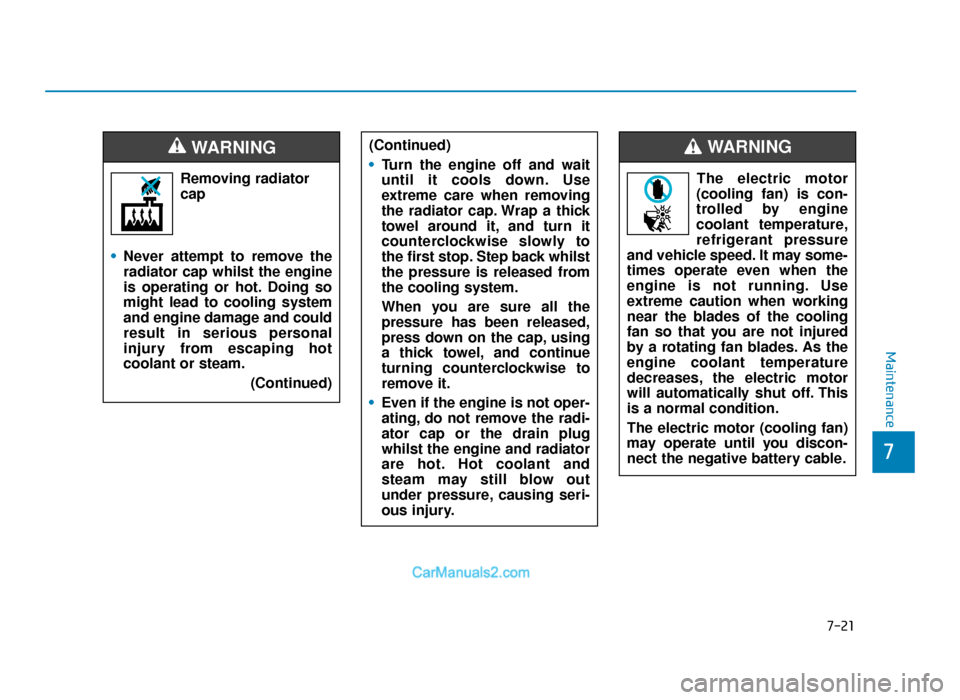
7-21
7
Maintenance
Removing radiatorcap
• Never attempt to remove the
radiator cap whilst the engine
is operating or hot. Doing so
might lead to cooling system
and engine damage and could
result in serious personal
injury from escaping hot
coolant or steam.
(Continued)
WARNING (Continued)
•Turn the engine off and wait
until it cools down. Use
extreme care when removing
the radiator cap. Wrap a thick
towel around it, and turn it
counterclockwise slowly to
the first stop. Step back whilst
the pressure is released from
the cooling system.
When you are sure all the
pressure has been released,
press down on the cap, using
a thick towel, and continue
turning counterclockwise to
remove it.
• Even if the engine is not oper-
ating, do not remove the radi-
ator cap or the drain plug
whilst the engine and radiator
are hot. Hot coolant and
steam may still blow out
under pressure, causing seri-
ous injury.
The electric motor
(cooling fan) is con-
trolled by engine
coolant temperature,
refrigerant pressure
and vehicle speed. It may some-
times operate even when the
engine is not running. Use
extreme caution when working
near the blades of the cooling
fan so that you are not injured
by a rotating fan blades. As the
engine coolant temperature
decreases, the electric motor
will automatically shut off. This
is a normal condition.
The electric motor (cooling fan)
may operate until you discon-
nect the negative battery cable.
WARNING
TLe UK 7.qxp 5/10/2018 1:33 PM Page 21
Page 571 of 685
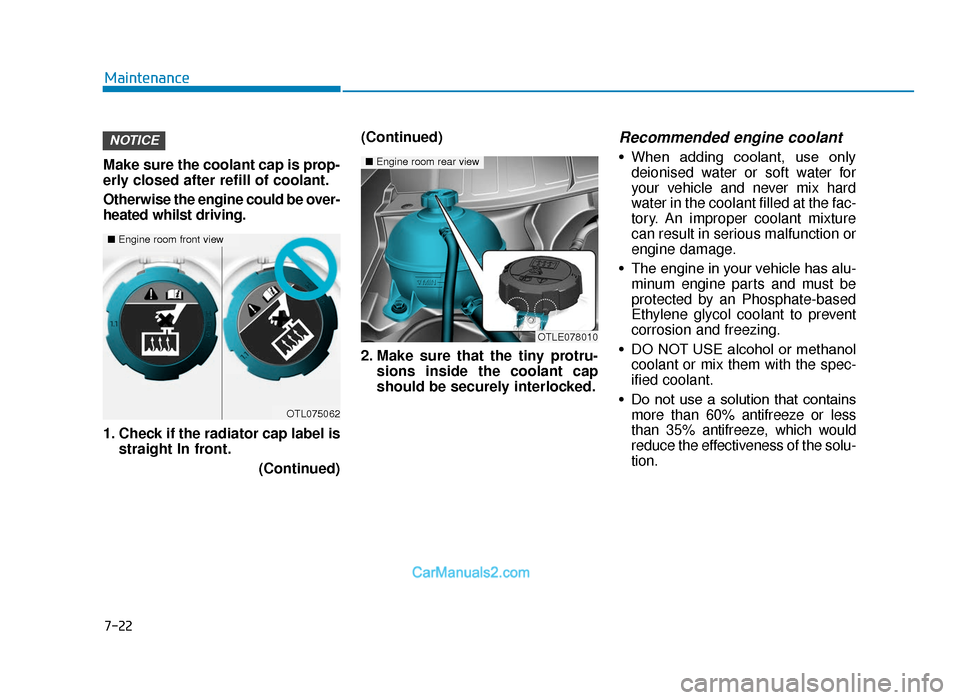
7-22
Maintenance
Make sure the coolant cap is prop-
erly closed after refill of coolant.
Otherwise the engine could be over-
heated whilst driving.
1. Check if the radiator cap label is straight In front.
(Continued)(Continued)
2. Make sure that the tiny protru-
sions inside the coolant cap
should be securely interlocked.
Recommended engine coolant
• When adding coolant, use onlydeionised water or soft water for
your vehicle and never mix hard
water in the coolant filled at the fac-
tory. An improper coolant mixture
can result in serious malfunction or
engine damage.
• The engine in your vehicle has alu- minum engine parts and must be
protected by an Phosphate-based
Ethylene glycol coolant to prevent
corrosion and freezing.
• DO NOT USE alcohol or methanol coolant or mix them with the spec-
ified coolant.
• Do not use a solution that contains more than 60% antifreeze or less
than 35% antifreeze, which would
reduce the effectiveness of the solu-
tion.
NOTICE
OTL075062
■ Engine room front view
OTLE078010
■Engine room rear view
TLe UK 7.qxp 5/10/2018 1:33 PM Page 22
Page 572 of 685
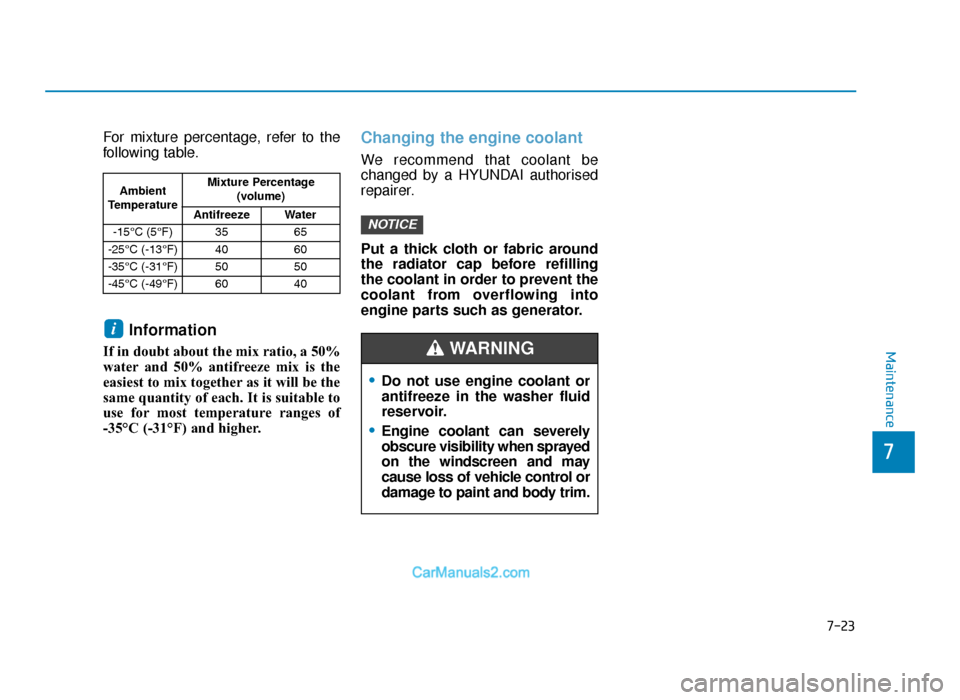
7-23
7
Maintenance
For mixture percentage, refer to the
following table.
Information
If in doubt about the mix ratio, a 50%
water and 50% antifreeze mix is the
easiest to mix together as it will be the
same quantity of each. It is suitable to
use for most temperature ranges of
-35°C (-31°F) and higher.
Changing the engine coolant
We recommend that coolant be
changed by a HYUNDAI authorised
repairer.
Put a thick cloth or fabric around
the radiator cap before refilling
the coolant in order to prevent the
coolant from overflowing into
engine parts such as generator.
NOTICE
i
Ambient
Temperature Mixture Percentage
(volume)
Antifreeze Water
-15°C (5°F) 35 65
-25°C (-13°F) 40 60
-35°C (-31°F) 50 50
-45°C (-49°F) 60 40
•Do not use engine coolant or
antifreeze in the washer fluid
reservoir.
•Engine coolant can severely
obscure visibility when sprayed
on the windscreen and may
cause loss of vehicle control or
damage to paint and body trim.
WARNING
TLe UK 7.qxp 5/10/2018 1:33 PM Page 23
Page 574 of 685

7-25
7
Maintenance
WASHER FLUID
Checking the washer fluid
level
The reservoir is translucent so that
you can check the level with a quick
visual inspection.
Check the fluid level in the washer
fluid reservoir and add fluid if neces-
sary.
Plain water may be used if washer
fluid is not available.
However, use washer solvent with
antifreeze characteristics in cold cli-
mates to prevent freezing.Do not use engine coolant or
antifreeze in the washer fluid
reservoir.
Checking the parking brake
Check the stroke of the parking
brake by counting the number of
“clicks’’ heard whilst fully applying it
from the released position. Also, the
parking brake alone should securely
hold the vehicle on a fairly steep
grade. If the stroke is more or less
than specified, we recommend that
the system be serviced by a
HYUNDAI authorised repairer.
Stroke : 5~6 “clicks’’ at a force of
20 kg (44 lbs, 196 N).
NOTICE
OTLE078105
PARKING BRAKE
OTLE055011R
•Engine coolant can severely
obscure visibility when
sprayed on the windscreen
and may cause loss of vehicle
control or damage to paint
and body trim.
• Windscreen Washer fluid
agents contain some amounts
of alcohol and can be flamma-
ble under certain circum-
stances. Do not allow sparks
or flame to contact the washer
fluid or the washer fluid reser-
voir. Damage to the vehicle or
occupants could occur.
• Windscreen washer fluid is
poisonous to humans and
animals. Do not drink and
avoid contacting windscreen
washer fluid. Serious injury or
death could occur.
WARNING
TLe UK 7.qxp 5/10/2018 1:33 PM Page 25
Page 642 of 685
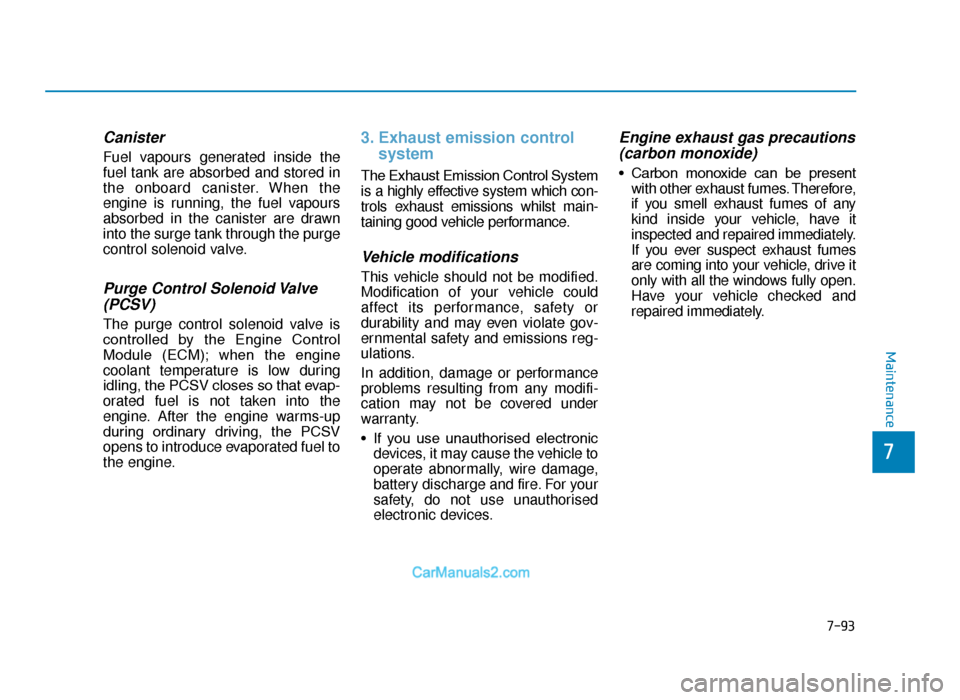
7-93
7
Maintenance
Canister
Fuel vapours generated inside the
fuel tank are absorbed and stored in
the onboard canister. When the
engine is running, the fuel vapours
absorbed in the canister are drawn
into the surge tank through the purge
control solenoid valve.
Purge Control Solenoid Valve(PCSV)
The purge control solenoid valve is
controlled by the Engine Control
Module (ECM); when the engine
coolant temperature is low during
idling, the PCSV closes so that evap-
orated fuel is not taken into the
engine. After the engine warms-up
during ordinary driving, the PCSV
opens to introduce evaporated fuel to
the engine.
3. Exhaust emission control system
The Exhaust Emission Control System
is a highly effective system which con-
trols exhaust emissions whilst main-
taining good vehicle performance.
Vehicle modifications
This vehicle should not be modified.
Modification of your vehicle could
affect its performance, safety or
durability and may even violate gov-
ernmental safety and emissions reg-
ulations.
In addition, damage or performance
problems resulting from any modifi-
cation may not be covered under
warranty.
• If you use unauthorised electronic
devices, it may cause the vehicle to
operate abnormally, wire damage,
battery discharge and fire. For your
safety, do not use unauthorised
electronic devices.
Engine exhaust gas precautions (carbon monoxide)
• Carbon monoxide can be present
with other exhaust fumes. Therefore,
if you smell exhaust fumes of any
kind inside your vehicle, have it
inspected and repaired immediately.
If you ever suspect exhaust fumes
are coming into your vehicle, drive it
only with all the windows fully open.
Have your vehicle checked and
repaired immediately.
TLe UK 7.qxp 5/10/2018 1:40 PM Page 93
Page 666 of 685
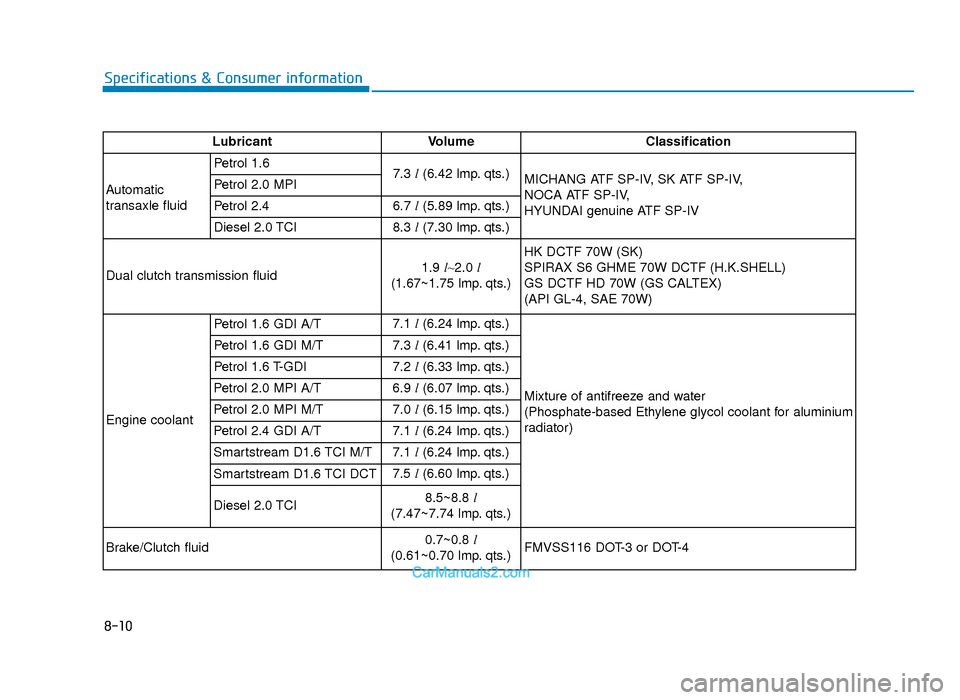
8-10
Specifications & Consumer information
LubricantVolume Classification
Automatic
transaxle fluid Petrol 1.6
7.3l(6.42 lmp. qts.)
MICHANG ATF SP-IV, SK ATF SP-IV,
NOCA ATF SP-IV,
HYUNDAI genuine ATF SP-IV
Petrol 2.0 MPI
Petrol 2.4
6.7
l(5.89 lmp. qts.)
Diesel 2.0 TCI 8.3
l(7.30 lmp. qts.)
Dual clutch transmission fluid 1.9
l~2.0 l
(1.67~1.75 lmp. qts.) HK DCTF 70W (SK)
SPIRAX S6 GHME 70W DCTF (H.K.SHELL)
GS DCTF HD 70W (GS CALTEX)
(API GL-4, SAE 70W)
Engine coolant Petrol 1.6 GDI A/T
7.1
l(6.24 lmp. qts.)
Mixture of antifreeze and water
(Phosphate-based Ethylene glycol coolant for aluminium
radiator)
Petrol 1.6 GDI M/T
7.3
l(6.41 lmp. qts.)
Petrol 1.6 T-GDI 7.2
l(6.33 lmp. qts.)
Petrol 2.0 MPI A/T 6.9
l(6.07 lmp. qts.)
Petrol 2.0 MPI M/T 7.0
l(6.15 lmp. qts.)
Petrol 2.4 GDI A/T 7.1
l(6.24 lmp. qts.)
Smartstream D1.6 TCI M/T 7.1
l(6.24 lmp. qts.)
Smartstream D1.6 TCI DCT 7.5
l(6.60 lmp. qts.)
Diesel 2.0 TCI 8.5~8.8
l
(7.47~7.74 lmp. qts.)
Brake/Clutch fluid 0.7~0.8
l
(0.61~0.70 lmp. qts.) FMVSS116 DOT-3 or DOT-4
TLe UK 8.qxp 6/12/2018 3:17 PM Page 10
Page 678 of 685

I-5
Emergency Stop Signal (ESS) ......................................5-66
Emergency whilst driving...............................................6-2If the engine stalls at a crossroad or crossing ............6-3
If the engine stalls whilst driving ................................6-2
If you have a flat tyre whilst driving ..........................6-3
Emergency towing .......................................................6-44
Emission control system ...............................................7-92 Adding the urea solution .........................................7-102
Clearing the vehicle-restarting restriction ...............7-101
Crankcase emission control system ...........................7-92
Evaporative emission control system ........................7-92
Exhaust emission control system...............................7-93
Low urea warning message .......................................7-99
Malfunction with the SCR system...........................7-100
Selective catalytic reduction ......................................7-98
Storing the urea solution ..........................................7-105
Urea gauge .................................................................7-98
Urea solution purity .................................................7-105
Engine ........................................................................\
.....8-2
Engine compartment ...............................................1-6, 7-3
Engine coolant ..............................................................7-20
Engine number..............................................................8-15 Engine oil......................................................................7-\
15
Checking the engine oil and filter .............................7-18
Checking the engine oil level (Diesel Engine) ..........7-17
Checking the engine oil level (Petrol Engine) ..........7-15
Engine overheats.............................................................6-8
Engine start/Stop button ...............................................5-11
Engine will not start .......................................................6-4 If the engine doesn't turn over or turns over slowly....6-4
If the engine turns over normally but doesn't start ......6-4
Evaporative emission control system ...........................7-92
Exhaust emission control system .................................7-93
Explanation of scheduled maintenance items ..............7-12
Exterior care .................................................................7-83
Exterior features ...........................................................3-42 Bonnet ........................................................................\
3-42
Fuel filler door ...........................................................3-44
Exterior features .........................................................3-183 Roof rack .................................................................3-183
Exterior overview ....................................................1-2, 1-3
I
Index
TLe UK Index.qxp 6/12/2018 3:27 PM Page 5